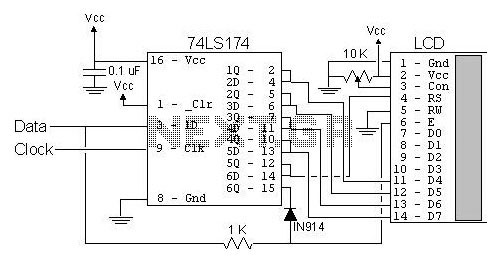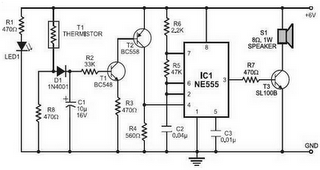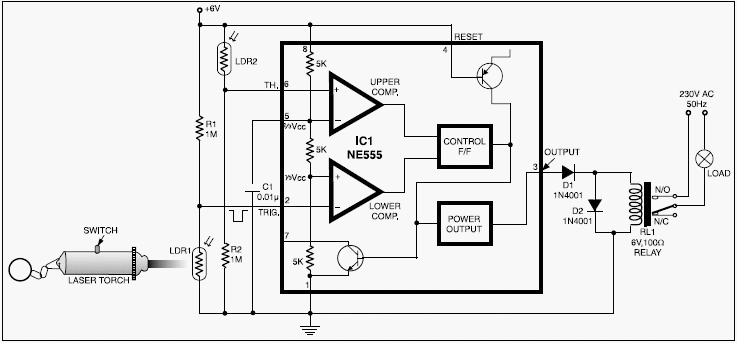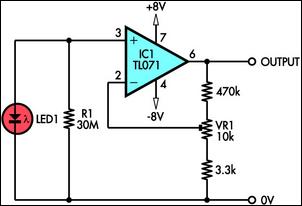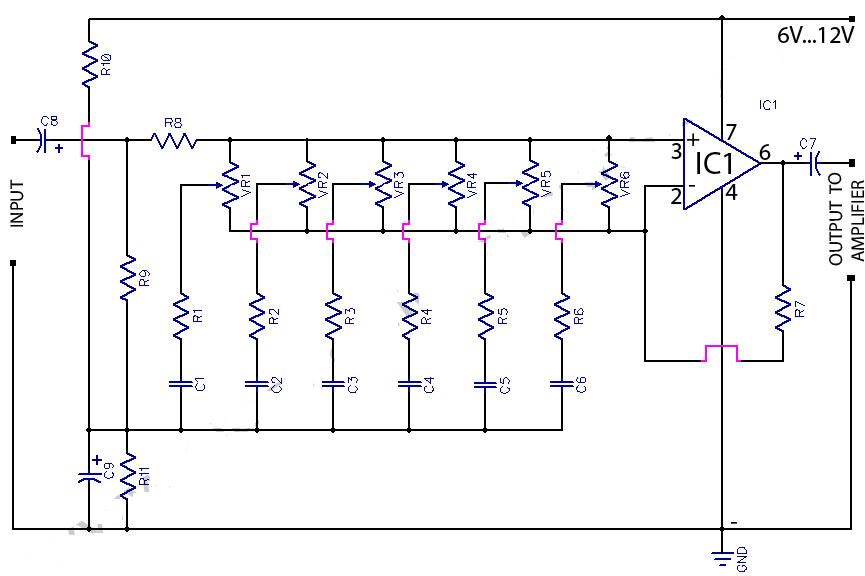
CMOS Toggle Flip Flop Using Laser Pointer

The circuit described operates similarly to a previous design but utilizes a laser pointer to activate the relay instead of a push button. An IR photo transistor (model Q1, Radio Shack 276-145A or equivalent) is connected to the set input (pin 6). It is essential to shield the photo transistor from direct light to ensure that the voltage at the set input (pin 6) remains below 1 volt under normal ambient conditions. When illuminated by the laser pointer or another light source, the voltage increases to over 10 volts. The reset time for the circuit is approximately half a second, using a 4.7 µF capacitor, which prevents the circuit from toggling more than once within that interval. A 10K resistor and diode provide a quicker discharge path for the 4.7 µF capacitor, allowing the circuit to be retoggled in under one second. The 3K resistor in series with the photo transistor may require adjustment for optimal performance. The relay used is a solid-state type, suitable for controlling lights or other resistive loads up to 3 amps. A mechanical relay can also be employed, as shown in the previous circuit.
The circuit design incorporates an IR photo transistor as a critical component for detecting laser light. When the laser pointer is aimed at the photo transistor, it triggers a voltage increase sufficient to activate the relay, thus allowing for remote control applications. The use of a 4.7 µF capacitor is significant as it not only serves to delay the reset of the circuit but also ensures stable operation by preventing rapid toggling, which could lead to erratic behavior. The 10K resistor plays a dual role; it helps to limit current through the diode for safe operation while also facilitating faster capacitor discharge, enabling quick reactivation of the relay.
In applications where the circuit may be exposed to varying ambient light conditions, the shielding of the photo transistor becomes crucial to maintain reliable operation. Adjusting the 3K series resistor allows for fine-tuning of the sensitivity of the photo transistor, ensuring that it responds optimally to the laser light without being overly sensitive to other light sources. The choice of a solid-state relay is advantageous for applications involving resistive loads, as it offers faster switching times and increased durability compared to mechanical relays.
Overall, this circuit provides a versatile solution for remote relay activation using a laser pointer, suitable for various electronic applications requiring non-contact control.The circuit below is similar to the one above but can be used with a laser pointer to toggle the relay rather than a push button. The IR photo transistor Q1 (Radio Shack 276-145A) or similar is connected to the set input (pin 6). The photo transistor should be shielded from direct light so that the voltage at the set input (pin 6) is less than 1 v
olt under ambient conditions and moves to more than 10 volts when illuminated by the laser pointer or other light source. The reset time is about a half second using a 4. 7uF cap which prevents the circuit from toggling more than once during a half second interval. The 10K resistor and diode provide a faster discharge path for the 4. 7uF cap so the circuit can be retoggled in less than 1 second. The 3K resistor in series with the photo transistor may need be adjusted for best performance. The relay shown is a solid state variety to be used with lights or other resistive loads at less than 3 amps.
A mechanical relay can also be used as shown in circuit above. We aim to transmit more information by carrying articles. Please send us an E-mail to wanghuali@hqew. net within 15 days if we are involved in the problems of article content, copyright or other problems. We will delete it soon. 🔗 External reference
The circuit design incorporates an IR photo transistor as a critical component for detecting laser light. When the laser pointer is aimed at the photo transistor, it triggers a voltage increase sufficient to activate the relay, thus allowing for remote control applications. The use of a 4.7 µF capacitor is significant as it not only serves to delay the reset of the circuit but also ensures stable operation by preventing rapid toggling, which could lead to erratic behavior. The 10K resistor plays a dual role; it helps to limit current through the diode for safe operation while also facilitating faster capacitor discharge, enabling quick reactivation of the relay.
In applications where the circuit may be exposed to varying ambient light conditions, the shielding of the photo transistor becomes crucial to maintain reliable operation. Adjusting the 3K series resistor allows for fine-tuning of the sensitivity of the photo transistor, ensuring that it responds optimally to the laser light without being overly sensitive to other light sources. The choice of a solid-state relay is advantageous for applications involving resistive loads, as it offers faster switching times and increased durability compared to mechanical relays.
Overall, this circuit provides a versatile solution for remote relay activation using a laser pointer, suitable for various electronic applications requiring non-contact control.The circuit below is similar to the one above but can be used with a laser pointer to toggle the relay rather than a push button. The IR photo transistor Q1 (Radio Shack 276-145A) or similar is connected to the set input (pin 6). The photo transistor should be shielded from direct light so that the voltage at the set input (pin 6) is less than 1 v
olt under ambient conditions and moves to more than 10 volts when illuminated by the laser pointer or other light source. The reset time is about a half second using a 4. 7uF cap which prevents the circuit from toggling more than once during a half second interval. The 10K resistor and diode provide a faster discharge path for the 4. 7uF cap so the circuit can be retoggled in less than 1 second. The 3K resistor in series with the photo transistor may need be adjusted for best performance. The relay shown is a solid state variety to be used with lights or other resistive loads at less than 3 amps.
A mechanical relay can also be used as shown in circuit above. We aim to transmit more information by carrying articles. Please send us an E-mail to wanghuali@hqew. net within 15 days if we are involved in the problems of article content, copyright or other problems. We will delete it soon. 🔗 External reference
